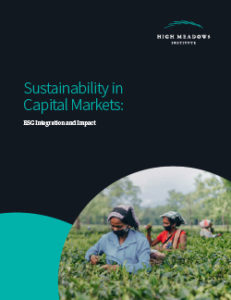 For the last eight years, we have tracked the progress of ESG in our biannual State of Sustainability in Capital Markets report. In that time, we have seen ESG go from the periphery of investment management to a core component of 21st century asset management. From a focus of niche players and discrete investment products, ESG is now central to the investment strategy of many of the world’s largest asset managers and a key component of investment stewardship. Essential to the rapid growth of ESG in investment management has been the concept of ESG financial materiality and the notion that ESG integration can help investment managers achieve competitive returns or even out-performance, creating a win-win value proposition that benefits both investors and society. In the last few years, however, this value proposition has come under increased scrutiny. On the one hand, critics argue that in reality, ESG’s impact on financial performance is driven disproportionately by demand, “something of a self-fulfilling prophecy, driven entirely by liquidity and flows.” More importantly, critics argue that ESG is just greenwashing and not creating a meaningful impact on environmental and societal challenges, despite its claims, and is simply perpetuating an illusion that markets can solve the systemic challenges we face. This is now even leading to legal action, as we saw with the German police raid on Deutsche Bank and its asset management unit DWS over greenwashing claims.
For the last eight years, we have tracked the progress of ESG in our biannual State of Sustainability in Capital Markets report. In that time, we have seen ESG go from the periphery of investment management to a core component of 21st century asset management. From a focus of niche players and discrete investment products, ESG is now central to the investment strategy of many of the world’s largest asset managers and a key component of investment stewardship. Essential to the rapid growth of ESG in investment management has been the concept of ESG financial materiality and the notion that ESG integration can help investment managers achieve competitive returns or even out-performance, creating a win-win value proposition that benefits both investors and society. In the last few years, however, this value proposition has come under increased scrutiny. On the one hand, critics argue that in reality, ESG’s impact on financial performance is driven disproportionately by demand, “something of a self-fulfilling prophecy, driven entirely by liquidity and flows.” More importantly, critics argue that ESG is just greenwashing and not creating a meaningful impact on environmental and societal challenges, despite its claims, and is simply perpetuating an illusion that markets can solve the systemic challenges we face. This is now even leading to legal action, as we saw with the German police raid on Deutsche Bank and its asset management unit DWS over greenwashing claims.
In our new report, Sustainability in Capital Markets: ESG Integration and Impact, we look at the drivers behind the push for ESG impact measurement and the challenges it poses for investment management. We find that, as with ESG, standards for defining and disclosing data on non-material societal impacts is complicated by the lack of widely agreed upon impact measurement frameworks and disclosure standards. While ESG integration, sustainable finance 2.0, was based on a single materiality framework focused on financial materiality and risk, sustainable finance 3.0 requires a double materiality framework that also takes into account and measures systemic societal impacts of investment decisions.
Surveying leading institutional investment managers in capital markets, we find that the adoption of a double materiality framework in mainstream ESG investment management is currently still in its early days, with some progress among asset managers with high public equities exposure. Private equity and fixed income remain at the starting gate for the most part.
As we look forward, there is no question that the move to sustainable finance 3.0 is here to stay. Investor interest in this “double materiality” approach is growing, with more than half of institutional investors in a recent Schroders poll saying that their primary focus now is the desire to positively impact society and the planet (54%), overtaking aligning to corporate/internal values (52%). At the same time, recent initiatives like the Capitals Coalition and the Impact-Weighed Accounts Initiative are creating new pathways and frameworks for impact integration, while the recent EU Corporate Sustainability Reporting Directive (CSRD) will support the Sustainable Finance Disclosure Regulation (SFDR) built around a double materiality framework.
While in many ways an even more challenging journey than the move to sustainable finance 2.0, the direction of travel is clear and it may surprise us how quickly impact and sustainable finance 3.0 become an integrated part of mainstream investment management. At HMI, we look forward to tracking and reporting on progress.
